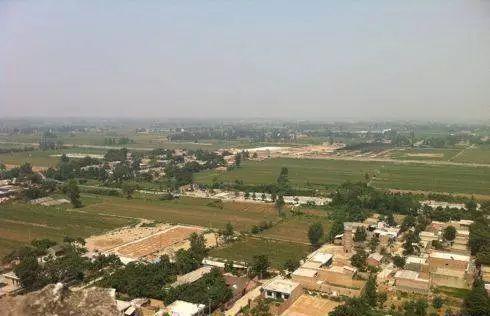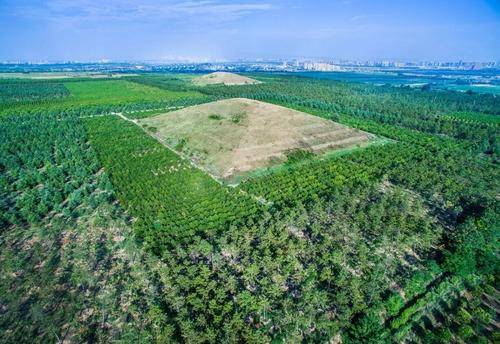Changling of Han Dynasty
Changling was built in the second year after Liu Bang became emperor, modeled after Chang'an. It is the tomb of Emperor Gaozu of Han, Liu Bang, and Empress Lü. The two tombs are of equal size. There are many other tombs near Changling, such as those of Xiao He, Cao Shen, Zhou Bo, and Zhou Yafu. During Liu Bang's lifetime, he moved to the noble area to guard the tomb. The palace attendants in the tomb, like the emperor and empress during their lifetime, respectfully served four meals a day. The lights in the tomb were always on, just as they were when Gaozu was alive, but now they can no longer live.
Hanyangling
Compared to other tombs, Hanyangling is more distinctive. It has a glass passage built on the original site, through which we can clearly see various artifacts excavated in the underground museum. Hanyangling is a mysterious underground kingdom. The terracotta figures unearthed from Hanyangling are of various types, such as warrior figures, female figures, eunuch figures, livestock figures, etc. From the clothing styles, actions, and expressions of these terracotta figures, we can see the culture that was esteemed in society at that time, which includes both Confucian and Taoist cultural characteristics. Everyone who visits the Hanyangling Museum can clearly see that the terracotta figures are more solemn than the Qin terracotta warriors, with softer expressions. At the same time, from the ox figures unearthed from Hanyangling, we can also see the economic conditions and dietary characteristics of the Han Dynasty. The terracotta figures of Hanyangling are the most direct historical and political materials that distinguish them from the Qin Terracotta Warriors and Tang Dynasty terracotta figures, and they are the main basis for studying a series of historical events of the Han Dynasty.
Maoling Mausoleum
The Maoling Mausoleum of Emperor Wu of Han, Liu Che, is the largest among the imperial tombs of the Western Han Dynasty. Emperor Wu of Han, the fifth emperor of the Western Han Dynasty, reigned for fifty-four years. He was known for his diligent governance and unique Confucian policies, distinct from his predecessors. His greatest achievement was the complete dismantling of the Xiongnu threat to China since the Qin Dynasty, consolidating the unity of multiple ethnic groups and establishing the prosperous era of Emperor Wu. During his reign, China achieved its greatest unification. However, in the process of eliminating the Xiongnu, he nationalized salt and iron, leading to hardships for the people. For a country, an emperor's duty is not only to maintain stability but also to ensure the well-being of the people. Thus, his reign had both merits and demerits. According to historical records, the Maoling Mausoleum was built in 53 AD, with one-third of the national tax revenue used annually for its construction. Therefore, the mausoleum is grand and unprecedented in scale, often referred to as the 'Eastern Pyramid.' Additionally, the burial items in Maoling are the most numerous among Han tombs. Historical documents state that there were so many burial items that some could not be placed inside the tomb and were left outside the mausoleum city. Despite three large-scale tomb robberies in history, the artifacts unearthed from Maoling are still abundant, including over 200 precious items such as the gilded bronze horse and the gilded silver bamboo joint censer.
Han Pingling
Pingling is the joint burial tomb of Emperor Zhao of Han, Liu Fuling, and Empress Dowager Shangguan. It is named 'Pingling' because it is located on the edge of a plain. Liu Fuling was the son of Emperor Wu of Han, Liu Che, and Zhao Jieyu. He ascended the throne in 186 BC at the age of 8. During his reign, the young ministers were strong, and the powerful minister Huo Guang held power. At that time, there were internal rebellions by King Xiaozhuang and border insurgents, external invasions by the Xiongnu, and internal power struggles with Huo Guang. Disasters struck repeatedly. In 174 BC, Liu Fuling, at the age of 21, mysteriously died in Weiyang Palace and was subsequently buried in the Pingling cemetery.
Han Huiling
The tomb is divided into three parts: the mausoleum, the tomb city, and the burial area. Various sizes of burial tombs have been excavated, and colorful pottery has been unearthed, including warrior figurines, music and dance figurines, and livestock figurines. From these colorful pottery pieces, one can see the social appearance, living conditions, and clothing styles of people during the Han Dynasty. The expressions on these pottery figurines indicate that Anling is the first tomb among all the tombs where a moat and city wall were found to be parallel. Additionally, many pottery figurines unearthed in Anling are well worth seeing.













